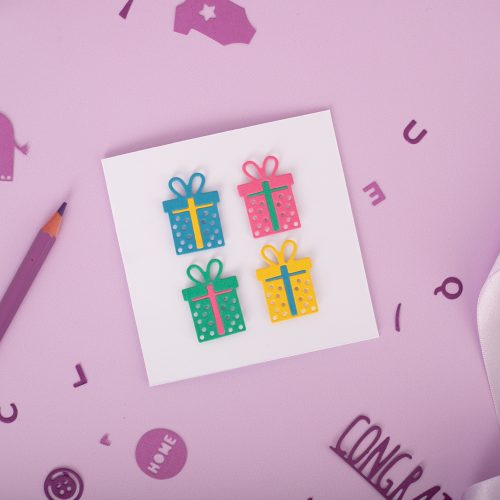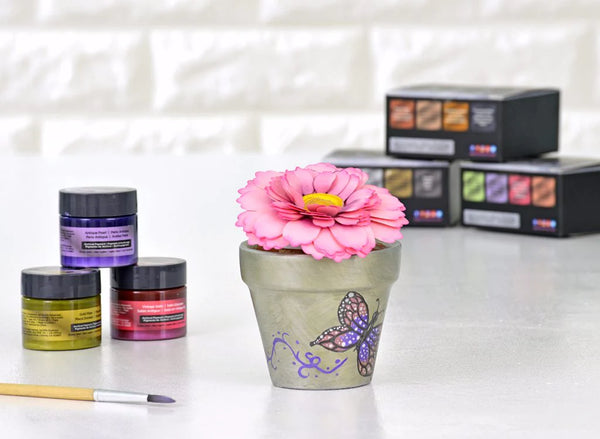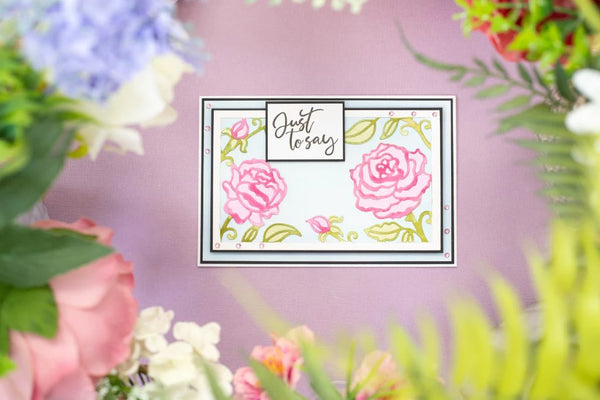The beginner's guide to stencilling
- Read time: 7 minutes
- Written by: Crafter's Companion
Stencilling is a craft and art form that has been around for years – 35,000 to be exact! It’s loved by children for making fun shapes in drawings and loved by adults for creating beautiful backgrounds for projects, but where exactly do you start? If this is a question you’ve been asking yourself, you’re going to love this post!
We’ve put together a few hints and tips for beginner’s in the world of stencilling, including a definition of the craft, how to use stencils and the different types of techniques you can use to produce the most amazing effects. Take a look and we promise, you’ll be adding backgrounds, layered images and stencilled embellishments in no time at all!

What is stencilling?
A stencil is a thin sheet of material with holes cut in to form an image or letters. They can be made from a range of materials, such as paper, wood or metal, but they are most commonly made from plastic, as they are easier to clean of any excess ink.
This thin sheet is then placed over the material that you would like to transfer the image on to, which could be paper, card or fabric, and a colouring medium is applied to the gaps. This creates the crisp transfer of the image or phrase, then you’re free to wipe the stencil clean and re-use it again another day!
You can use a variety of colouring mediums with stencils – it’s all about preference! We love using inks (which we’ll talk about later), but you can also use paint, pencil, marker pen and so much more. Each one will give you a different effect, so it all depends on how you’d like your finished piece to look.
What is the basic method for stencilling?
We’ll chat a little bit about the super fun stencilling techniques that you can do in a little while, but first, let’s talk through the basic steps that you can take to achieve the most crisp image possible.
- Lay down your base material. We like to lay ours on top of the 13″ x 19″ Glass Cutting Mat, just in case we have any spills.
- Choose your stencil, then lay it on top of your base material where you would like the image to be positioned. Fix it in place with Repositionable Adhesive or Low Tack Tape. As this tape doesn’t have a permanent bond, it will keep your stencil steady, but you’ll be able to remove it with ease once your image has been created.
- Now comes the fun part! Choose your colouring medium and apply it to the open spaces in the stencil. This could be colouring in with a pencil or marker, or using a brush to add a thin coat of paint. We recommend using a Spectrum Noir Blender Tool and the Quick Dry Inkpads for stunning colour payoff.
- Once you’ve filled the gaps with the colours of your choice, carefully peel off the Low Tack Tape and remove the stencil. Your beautiful image should be beneath!
Once you’ve got to grips with this method, you’ll be able to experiment and play about with other techniques. You could even have a go at using our Layering Stencils, which you can see in the video below.
Which inkpads should you use for stencilling?
By far, our favourite way to use stencils is with the Spectrum Noir Quick Dry Inkpads, as suggested in the basic method. These water-based, acid free and fully archival inkpads are available in 36 colours, ready to co-ordinate and combine. What makes these inkpads unique is their super-fast drying time. Within seconds of applying the ink to your chosen material, it begins to dry, which makes these inkpads perfect for creating a layered stamp effect. However, they can also be used with brushes for incredible detail.
We also love the effects that can be created when using the Spectrum Noir Water-Reactive Inkpads. These have been designed to be used with water to produce incredible watercolour effects. Just imagine how beautiful they’d be when brushed over a stencil! They have a slow drying time, so you can blend colours easily and produce stress effects.
Lastly, we would recommend the Spectrum Noir Opaque Pigment Inkpads, not only because they pack a great, colourful punch, but you can also heat emboss with them! When they dry, they give a shiny, enamel-like finish – all you need to do is dab the inkpad over the stencil until you have the coverage you desire.

What techniques can you use in stencilling?
- Reverse stencilling – how about using your stencil like a stamp? Simply add your colour to the solid ares of the stencil, flip it over and press down into your material. This will give the design a negative space!
- Spritzing – if you want a super distressed look to your final image, try using spritz ink. You can spray this over the stencil and when it’s lifted, the final look will have a slight splatter effect.
- Dabs and strokes – take a slightly more abstract effect to your stencilled image and go in with a heavy hand. Instead of looking for a smooth colour laydown, go in with a brush and some paint. Dab, splash and stroke to add texture and incredible dimension.
- Use paste and a palette knife – as seen in Jan’s video above, by using a palette knife and Structure Paste, she was able to get a 3D textured effect to her piece. You can use Rusty Patina, Glitter Paste or Texture Paste – all of which will add an exciting, multi media edge to your piece.
- Stamp over the top – incorporate another of our favourite crafty techniques – stamping! This is a brilliant way to add a unique look to a stencil, so you could repeat stamps to form an almost-solid image. Try it out with an occasion stencil and the relevant sentiment stamps!

How to make the most of your stencils
- Stencils are super versatile, but only if they are cleaned after every use. Make sure you wipe down the stencils every time you use them to avoid staining and preventing the build up of product. You can use warm water and soap or a simple baby wipe.
- Never scrub your stencils because you can damage them or tear the detailed areas.
- Make sure you store your stencils flat and between two pieces of cardboard, if available. This will prevent them from buckling.
- To avoid messy edges, make sure you use a thin layer of your colouring medium. Of course, if you don’t mind about having abstract edges, go as thick as you like!
We hope that this handy beginner’s guide has helped you out in some way, whether you’re totally new to stencilling or a bit of a pro, and we can’t wait to see how you put your stencils to good use! Make sure you show us by sharing your photos on Facebook, Twitter or Instagram using the hashtag #crafterscompanion.












